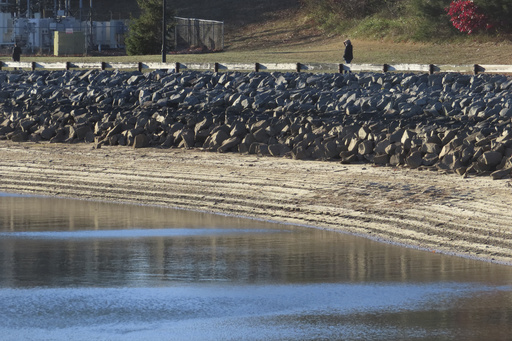
BRICK, N.J. — In various regions across the United States, unprecedented dry conditions are prompting concerns about potential new wildfires, in addition to risks that could jeopardize drinking water supplies if significant rain does not materialize soon.
On Wednesday, firefighters were engaged in combating wildfires stretching from California to New York, facing obstacles such as high winds and parched landscapes.
New Jersey Governor Phil Murphy issued a drought warning on Wednesday, urging residents to consider the seriousness of the situation. “We have a very dry winter ahead of us,” he stated.
In California, firefighting crews made significant strides against a substantial wildfire in Ventura County, located northwest of Los Angeles. This fire, which ignited a week ago, had rapidly expanded due to the dry Santa Ana winds. As of Wednesday, the Mountain fire was reported to be 60% contained.
According to Cal Fire, the state agency, it remains hopeful that the fire will stay within established containment lines without further growth and mentioned that firefighters would be withdrawing from the area, allowing residents to return once it is deemed safe. This fire has burned across 32 square miles (83 square kilometers), forcing thousands to evacuate and resulting in the destruction of over 215 structures, primarily homes, with at least 210 others suffering damage.
While California’s conditions are classified as “abnormally dry,” they have not reached severe drought levels for most of the state, as reported by the Nebraska-based National Drought Mitigation Center.
The situation is more dire on the East Coast, particularly concerning a wildfire near the New Jersey-New York state line, which has halted progress. As of Wednesday morning, the Jennings Creek fire was only 30% contained, the same status as the previous night. It has affected a total of 2,283 acres (3.6 square miles) in Passaic County, New Jersey, and an additional 2,100 acres (3.3 square miles) in Orange County, New York.
Greg McLaughlin, an official with the New Jersey Forest Fire Service, indicated that the rugged mountainous terrain, coupled with high winds and limited road access, has complicated efforts to manage the fire from the ground. A helicopter equipped to drop water has been deployed, but traditional firefighting tools, like bulldozers, have not proven effective in this instance.
The wildfire even claimed the life of a New York state parks employee assisting with firefighting efforts over the weekend.
In both New Jersey and New York, the ongoing dry conditions are raising alarms not just for firefighting crews but also regarding the sustainability of drinking water resources. On Wednesday, New Jersey officials declared a drought warning, urging residents to adopt voluntary conservation measures while trying to avoid imposing mandatory restrictions.
At the time of the warning, two of New Jersey’s major reservoirs were at 51% and 45% of their total capacity, sufficient for current needs but low enough to elicit concerns about potential consequences of further low rainfall. One river contributing to the drinking water supply was at a mere 14% of its usual flow.
Governor Murphy encouraged straightforward conservation steps: taking shorter showers, running dishwashers only when full, and turning off the faucet while brushing teeth.
New Jersey experienced the driest September and October on record; since August, the state has received just 2 inches (5 cm) of rainfall instead of the expected foot (0.3 meters). Forecasts offer little hope for significant rain in the near future.
The ground moisture levels are critically low. McLaughlin highlighted that the soil is dry almost 8 inches (20 centimeters) below the surface, with a dryness score of 748 on a scale where 800 indicates extreme conditions. This level has never been documented before.
A wildfire that sparked in New Jersey’s Wharton State Forest on July 4, attributed to illegal fireworks, has been considered contained for some time. Nevertheless, it has still been smoldering underground for four months, with potential to ignite again. “We have to monitor these fires for weeks or months,” McLaughlin commented.
Conditions are similarly concerning in New York, which issued a drought watch recently. Mayor Eric Adams has appealed to residents to partake in water conservation efforts by limiting shower times and repairing leaking faucets.
Last month, Central Park recorded only 0.01 inches (0.02 cm) of rain, an extraordinary departure from the average of about 4.4 inches (11.2 cm) typically expected in October. This deficiency made it the driest October in over a century and a half of records, as noted by the National Weather Service. In response to the ongoing dry spell, Massachusetts officially declared a drought on Tuesday due to persistent low rainfall.
